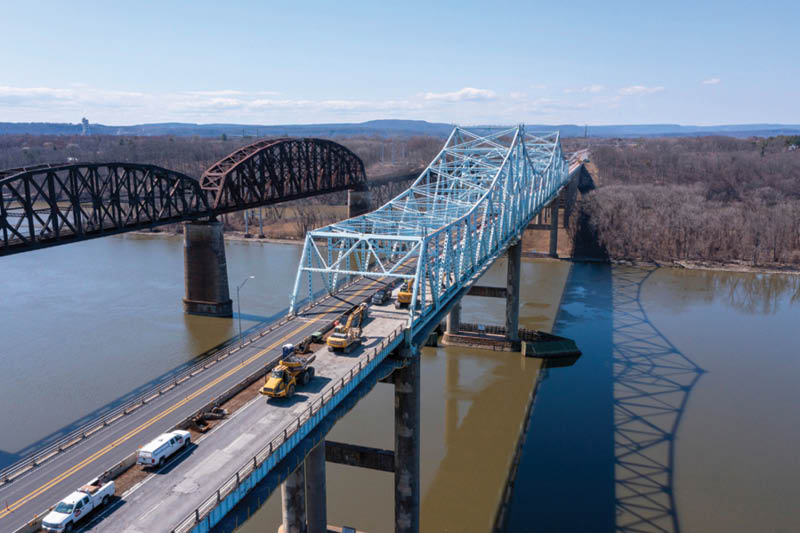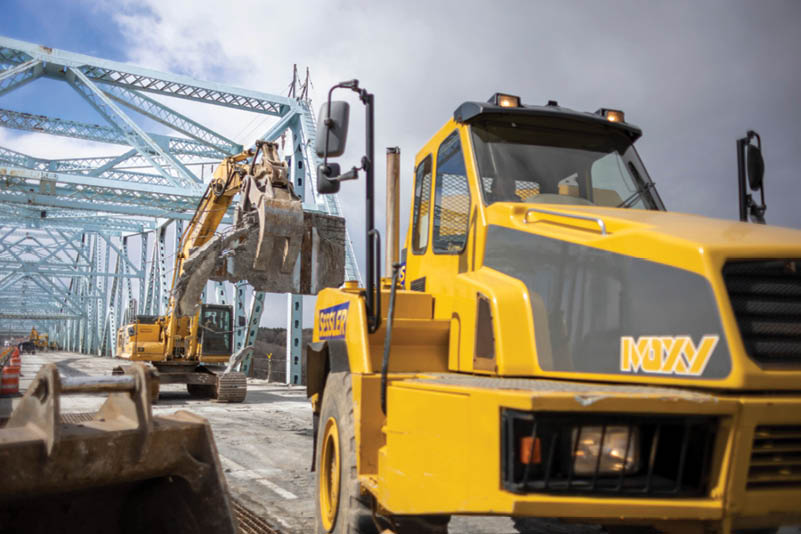Construction & Demolition Recycling Features Sessler Wrecking
Through careful planning, Sessler Cos. oversaw the removal of 217,250 square feet of concrete and 1,247 tons of steel as part of the Castleton-on-Hudson Bridge restoration project.
By Construction & Demolition Recycling, CDRecycler.com
BY HALEY RISCHAR | NOVEMBER DECEMBER 2023

For more than 65 years, the Castleton-on-Hudson Bridge in Albany, New York, has connected the New York State Thruway and the Massachusetts Turnpike. Because of its heavy traffic, the cantilever truss bridge has been restored multiple times since its inauguration, with a focus on the bridge’s eastbound side.
In 2022, the bridge underwent its most recent restoration, but this time for the westbound section, which spans more than a mile in length and more than 40 feet in width. The project, completed in August, included the total replacement of the concrete bridge deck and central divider.
Sessler Cos., based in Waterloo, New York, oversaw the demolition and managed to eliminate 217,250 square feet of concrete deck positioned atop the superstructure, according to the company’s website.
The company says the project encompassed the removal of a range of materials, including reinforced concrete, exodermic layers and open steel grid decking. Some stringer and floor beam components within the open grid deck zones also were extracted.
Working in tight conditions
“It was a very constricted site,” Sessler Cos. Director of Bridge Demolition Mike Karsten says of the Castleton-on-Hudson Bridge. “Anytime you’re working essentially in a two-lane-wide area, you don’t have a lot of room to pass equipment or people or get material off the bridge.”
For this job, Karsten says crews started in the middle of the bridge and worked in opposite directions to remove the existing deck. He says challenges could arise because of the length and narrowness of the bridge.
“The bridge is [more than] 5,000 feet long. … All the material—the concrete [and] demolition debris—had to be transported to the east side of the job. The steel—in the last phase of removal we removed a lot of grid decking—was being removed to the west side.”
He adds that an eastern portion of the bridge had to be completed early so the project’s general contractor could complete work on the Alfred H. Smith Memorial Bridge, a railroad bridge near the Castleton-on-Hudson Bridge.
To stay within the project’s timeline, crews relied on a fleet of hauling trucks, tractor-trailers, full-size and mini excavators, skid steers, shears and hoe rams to complete work quickly.
“At one time, we probably had a minimum of six excavators working, three in each direction,” Karsten says. “In the beginning, when we were tight with the schedule, I think we had four excavators on each side for a total of eight,” he says.
Each day, Sessler needed to remove a designated quantity of bridge deck to stay on schedule and fulfill project requirements. On the center truss spans, Karsten says crews removed more than 46,000 square feet of concrete in 10 days.
Sessler Cos. disposed of concrete debris on-site near the eastern portion of the bridge and sent extracted steel to Baroni Recycling in Poughkeepsie, New York.

“[Baroni] took all the steel, [but] there was a portion of the steel that was [purchased] by a local snowmobile club to create a bridge … in their trail network. We retained a few of the pieces, as well, just to use for the future,” Karsten says. “On a lot of the jobs we do, if the steel comes off the job and is suitable for reuse or possibly another job, we may save some of it.
“As far as structural steel goes, we always recover 100 percent,” he adds. “Depending on the project, we may recover some of the rebar from the concrete if it’s processed, but that wasn’t the case for this bridge.”
In total, Karsten says 1,247 tons of steel were recycled, and 5,200 cubic yards of concrete were removed.
Concrete extracted from the Castleton-on-Hudson Bridge project was used as fill near the site, Karsten says.
Plan your work, work your plan
To keep operations moving at constrained sites such as the Castleton-on-Hudson Bridge, Karsten says diligent planning is needed.
“You really have to plan your work and work your plan every single day,” he says. “You have to have the correct amount of equipment to move all the material that you’re removing; you have to have the right equipment to load and keep the whole process moving.
“At the same time, you want to use the minimum amount of employees that you can to complete a job like this,” he adds, noting that Sessler had 20 workers for this particular project—six operators and 14 laborers.
Construction to replace the eastbound deck of the bridge, which is the second phase of the roughly $77 million plan to make improvements to the bridge deck, is expected to begin in 2024.
The first phase, which involved Sessler, took roughly three years to complete and cost $47.6 million. The second project is estimated to cost $30 million. Karsten says Sessler has plans to bid for Phase II, as well.
“New York continues to make historic investments to rebuild and strengthen our transportation infrastructure,” New York Gov. Kathy Hochul says in an Aug. 25 news release announcing completion of Phase I. “Thousands of New Yorkers and companies rely on the Castleton-on-Hudson Bridge every day. With this rehabilitation project now complete, this vital gateway can better serve and connect communities in the region for years to come.”
Todd Worden, general superintendent of bridge demolition for Sessler, says, “In carrying out this crucial job, we maintained a steadfast commitment with little room for error. The success of this project lays on the shoulders of our team in the field, which involved precision burners, highly skilled operators and laborers and top of the line truck drivers. Seeing a project like Castleton through to completion with the amount of coordination and traffic control, with zero safety incidents, highlights the fantastic work of the Sessler Wrecking field staff.”
The two projects are expected to extend the life of the bridge by 50 years.



